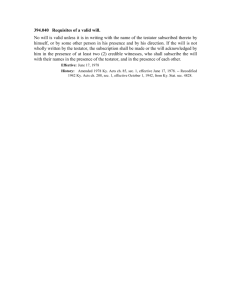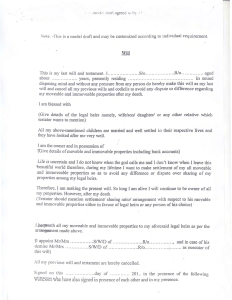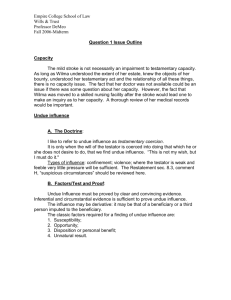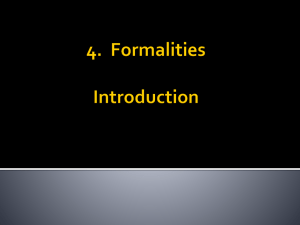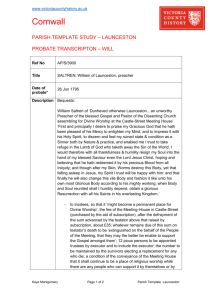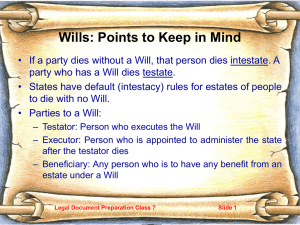ESTATES & TRUSTS – winter 2012 ANSWER OUTLINE
advertisement
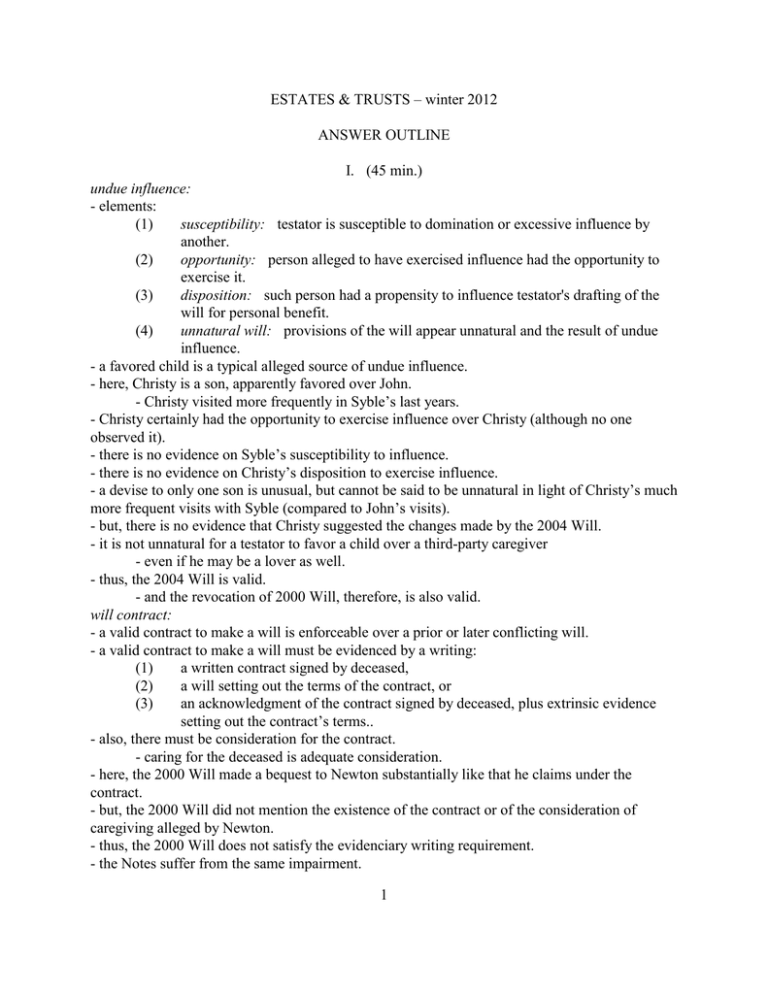
ESTATES & TRUSTS – winter 2012 ANSWER OUTLINE I. (45 min.) undue influence: - elements: (1) susceptibility: testator is susceptible to domination or excessive influence by another. (2) opportunity: person alleged to have exercised influence had the opportunity to exercise it. (3) disposition: such person had a propensity to influence testator's drafting of the will for personal benefit. (4) unnatural will: provisions of the will appear unnatural and the result of undue influence. - a favored child is a typical alleged source of undue influence. - here, Christy is a son, apparently favored over John. - Christy visited more frequently in Syble’s last years. - Christy certainly had the opportunity to exercise influence over Christy (although no one observed it). - there is no evidence on Syble’s susceptibility to influence. - there is no evidence on Christy’s disposition to exercise influence. - a devise to only one son is unusual, but cannot be said to be unnatural in light of Christy’s much more frequent visits with Syble (compared to John’s visits). - but, there is no evidence that Christy suggested the changes made by the 2004 Will. - it is not unnatural for a testator to favor a child over a third-party caregiver - even if he may be a lover as well. - thus, the 2004 Will is valid. - and the revocation of 2000 Will, therefore, is also valid. will contract: - a valid contract to make a will is enforceable over a prior or later conflicting will. - a valid contract to make a will must be evidenced by a writing: (1) a written contract signed by deceased, (2) a will setting out the terms of the contract, or (3) an acknowledgment of the contract signed by deceased, plus extrinsic evidence setting out the contract’s terms.. - also, there must be consideration for the contract. - caring for the deceased is adequate consideration. - here, the 2000 Will made a bequest to Newton substantially like that he claims under the contract. - but, the 2000 Will did not mention the existence of the contract or of the consideration of caregiving alleged by Newton. - thus, the 2000 Will does not satisfy the evidenciary writing requirement. - the Notes suffer from the same impairment. 1 part performance: - Newton did carry out the terms of the purported caregiving contract. - part performance can make an invalid oral contract enforceable. - because of a change of position of the contractee in reliance on the contract. - inducing a person to change his position in reliance on a purported contract is a species of fraud. - but, the UPC will contract provision does not provide for part performance in lieu of a writing. - and, there are no post-UPC Missouri cases in point - however, there is a pre-UPC decision adopting the part performance doctrine in a will contract case. - thus, Newton’s caregiving activities do not support a will contract. - although they may support quantum meruit compensation. - thus, the purported will contract does not preempt the 2000 Will. II. (30 min.) simultaneous death: - Uniform Simultaneous Death Act operates when times of death of testator and devisee cannot be determined. - in that situation, testator is presumed to die after devisee. - here, order of death could not be determined. - here, Jim is deemed to have died after Martha. lapse: - if devisee predeceased testator, under common law there is a lapse. - under anti-lapse statute, descendants take in lieu of deceased devisee. - anti-lapse statute does not apply to testator’s spouse, only to devisees who are descendants or relatives of testator. - the policy is to keep the estate’s assets in testator’s family rather than having them go to spouse’s family. But, statute deos not apply to Martha (spouse). - thus, Martha does not take assets in Jim’s estate. Martha’s heirs: - note: Elizabeth Major, Martha’s daughter by a prior marriage, would take any assets in Martha’s estate. - since Martha did not have a will, the intestacy law would determine who takes her assets. - Martha’s daughter would take ahead of her sister. (Children take ahead of siblings.) Jim’s heirs: - Jim’s devise to Martha lapsed; she is deemed to have predeceased Jim. - since Jim’s will did not contain a residuary clause, intestacy law would determine who takes his assets. - Jim’s survivors are his son, Thomas, and brother, Peter. - testator’s children take ahead of his siblings. 2 - adopted children are treated the same as natural children. - thus, Thomas should take the estate ahead of Peter. killer bar: - killers are barred from taking the victim’s property by devise or inheritance (in MO, by case decision, not by statute). - a killer should not profit from his misdeed. - thus, Thomas cannot take as heir. - so, Jim’s brother, Peter, takes as next heir. - bonus: if property acquired during marriage was jointly owned: - Peter, as Jim’s heir, would take ½. - Elizabeth, as Martha’s heir, would take the other ½. - via Uniform Simultaneous Death Dact and intestacy rules. III. (15 min.) undue influence: - definition: person persuades testatorto substitute person’s intentions for testator’s own. - elements of undue influence: (1) susceptibility: testator is susceptible to domination or excessive influence by another person). (2) opportunity: alleged influence hadthe opportunity to exercise undue influence. (3) disposition: alleged influencer had a propensity to influence testator’s drafting of the will for personal benefit.. (4) unnatural will: provisions of the will appear unnatural and the result of undlue influence.. - a parent-child relationship alone is not evidence of undue influence. - children are allowed to seek to influence their parents’ testamentary disposition because of the familial relationship. - discuss evidence: (1) susceptibility: Charles was old, and inference in weakened health. - but, no evidence of weakened mental acuity. (2) opportunity: Samuel visited Charles at time of will execution. - but, Samuel wasn’t present in lawyer’s office on day of will execution. (3) disposition: a few months after will execution, Samuel moved Charles to a nursing home closer to Samuel’s residence. - but that was under a durable power-of-attorney for health care. - post-execution behavior usually is irrelevant to behavior at time of will execution. (4) unnatural will: before will execution, Charles told people he intended to divided property equally among his 4 children; but his will divided his farm between his 2 sons, and gave a house to each of his 2 daughters. - no child was disinherited; rather, it was a different method of divided the property; it does not appear unnatural. - evidence of influence in a transaction subsequent to will execution is not evidence of undue influence at the time of will execution. 3 4 IV. (15 min.) existence of ambiguity in will: - “books” and “collections” are not inherently ambiguous terms and do not inherently conflict with each other. - therefore, there is no patent ambiguity in the will. plain meaning rule: terms in will are interpreted by convention word definitions. - legal terms are defined by their usual legal meanings. patent ambiguity: ambiguity on face of will. - can be resolved by extrinsic evidence. - but extrinsic evidence cannot be used to introduce ambiguity of term unambiguous on its face. latent ambiguity: - but if an ambiguity arises when the terms of the will are applied, there is a latent ambiguity. - here, the railroad books could be regarded both as “books” and as constituting a “collection”. - thus, two bequests could encompass the railroad books. - that creates a latent ambiguity. - extrinsic evidence can be used to resolve a latent ambiguity. - facts supporting railroad books as a “collection”: - railroad books constituted a reference library and were used by testator for academic research & teaching. - testator liked railroad history. - railroad books were inventoried, a practice common with collections. - the railroad books were valuable. - Paul told John that “he would enjoy them one day”. - all this delineates them from other books in the house.. - facts supporting characterization as “books”: - they are books. - wife Marianne helped do the railroad book inventory. facts supporting supporting advertisement posters as a “collection”: - people do collect posters. - Paul treated the posters as collected material. - Paul told John that “he would enjoy them one day” facts supporting characterization as “pictures”: - posters are a form of graphic arts, a type of “pictures”.. facts supporting railroad lanterns as a “collection”: - Paul told John that “he would enjoy them one day”. facts supporting characterization as “furnishings”: - none. It is a big stretch to consider them as household lighting devices. - devise of “books, pictures, ... and other articles of personal or household use” is similar to the statutory definition of exempt property. - thus, that clause would not have any greater meaning. - and, therefore, it would be be preempted by any specific devises of property which could fall within that clause. - result: - John: gets railroad book, advertisement poster and lantern collections. 5 - Marianne: household personalty, automobiles V. (15 min.) spendthrift trust: - a spendthrift trust is one in which the beneficiary is not empowered to alienate, convey, or anticipate distributions from the trust. - language of trust amendment contains those appropriate words to create a spendthrift trust. - thus, creditors cannot compel diversion of trust payments, but must attach them fter the beneficiary receives them. - a bankruptcy trustee is treated like any other creditor. - claim by bankruptcy trustee is not a “federal government” claim (exempted from operation of spendthrift clause). - thus, bankruptcy trustee is not entitled to diversion of the annual payments to Julie McCoy, but must attach them only after she receives them. revocability: - under Uniform Trust Code, trusts are revocable (unless made expressly irrevocable). RSMo § 456.6-602(1). - applies only to post-UTC trusts [1995]. - power of revocation retained by settlor encompasses power to modify. - here, Trust Amendmentwas post-UTC;. - thus, it is a valid modification. discretion: trust instrument contains an express discretionary payment clause. - beneficiary’s creditors cannot force trustee to exercise discretion in any particular way. - result: creditors cannot reach trust principal, cannot attach payments, and must wait until beneficiary receives a payment in order to attach it. VI. (30 min. total) SHORT ANSWER QUESTIONS A. (10 min.) anti-lapse statute: - anti-lapse statute applies where devisee predeceases testator. - anti-lapse statute provides that descendant takes devisee’s devise. - anti-lapse statute operates when the following conditions are satisfied: (1) devisee is a descendent, ancestor or relative of testator, and - intestacy determines who the descendant who takes. - here, Robert is the descendant of Keith. - thus, Robert takes the devise to Keith. 6 B. (10 min.) assisted testator signature: - will must be signed by testator in presence of two attesting witnesses. - testator must have mental capacity to execute a will. - when there is not a self-proving will affidavit attached to the will, executors must affirmatively prove will validity. - must prove testator mental capacity and signing by testator and two attesting witnesses in the presence of each other. - assisted signature is valid (authorized by statute). - evidence of physical incapacity to sign does not controvert validity of assisted signature. - here, there was evidence of testator’s request for assistance in signing will. That proves mental capacity and makes the signature valid. - thus, will is valid. C. (10 min.) methods for amending a trust: - a trust must be created by a writing. - but a trust can be modified orally. - of course, there must be testimony of witnesses who heard the oral modification. - unless the trust instrument requires a writing for modifications. - here, the trust instrument did require a writing. - here, there was a writing. - the trust instrument does not specifically address changes of beneficiaries; it only addressed trust modifications generally. - those trust modifications and revocations, by the trust terms, could be in whole or in part. here, removing one of several beneficiaries, is a partial modification. - it was done by a writing. - it is valid. VII. (30 min.) Briefly define the following terms: (1) Rule in Wild’s Case: “to A and A’s children” creates a single class with A and each of A’s children as equal members. (2) spendthrift trust: : beneficiary denied right to transfer, anticipate, or encumber trust income or corpus prior to time trustee makes distributions. (3) interested witness: an attesting witness who is devisee, and thus has a possible conflict of interest in testifying accurately about the will execution process. (4) overall portfolio rule: under “prudent investor rule”, look at results of overall portfolio, not at each individual investment separately. (5) exemptions and allowances: assets in gross probate estate which surviving spouse (or unmarried minor children) take ahead of creditors: exempt property, family maintenance allowance and homestead exemption. (6) acts of independent significance: changes of specific items of 7 property and of entry & exit of persons from the class after will is executed do not work an ademption of the legacy. (7) cy pres: doctrine enabling court to revise a charitable trust to analogous purpose when original purpose becomes impossible, unlawful or impracticable; prevents a lapse and reversion to settlor’s estate. (8) pretermitted child: : child born or adopted after will is executed – gets an intestate share unless the omission was intentional, child was given a substantial nonprobate distribution (like life insurance), or the bulk of the estate was given to the child’s surviving parent (and there was other children of that spouse alive at will execution). (9) joint will: one instrument executed by 2 or more testators as the will of both [all] of them; probated each time one of the testators dies. (10) latent ambiguity: seemingly unambiguous language when applied to facts are rendered ambiguous. 8
